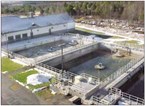Case Study: Optimizing Biological Phosphorus Removal From An AquaSBR® System

 The Middlbury Wastewater Treatment Plant located in Middlebury, Vermont treats domestic and industrial waste received from a local dairy and a brewery. Its original treatment system consisted of a flow-through activated sludge process with primary clarifiers, anaerobic digesters, and a four-train Rotating Biological Contactor (RBC) system. The RBC system was installed in 1980 but by the mid 1990s was plagued with mechanical failures. The plant was unable to meet its effluent requirements for BOD, TSS and Total Phosphorus. Since the plant was located in the center of town, the surrounding area was also burdened with odor problems from the facility’s primary clarifiers and aerated pre-equalization tank. Middlebury realized it was time to explore other secondary treatment technologies in order to alleviate its current problems and upgrade its facility to meet more stringent requirements.
The Middlbury Wastewater Treatment Plant located in Middlebury, Vermont treats domestic and industrial waste received from a local dairy and a brewery. Its original treatment system consisted of a flow-through activated sludge process with primary clarifiers, anaerobic digesters, and a four-train Rotating Biological Contactor (RBC) system. The RBC system was installed in 1980 but by the mid 1990s was plagued with mechanical failures. The plant was unable to meet its effluent requirements for BOD, TSS and Total Phosphorus. Since the plant was located in the center of town, the surrounding area was also burdened with odor problems from the facility’s primary clarifiers and aerated pre-equalization tank. Middlebury realized it was time to explore other secondary treatment technologies in order to alleviate its current problems and upgrade its facility to meet more stringent requirements.
Middlebury upgraded its facility in February 2000 by replacing the flowthrough activated sludge process and RBC system with a four-basin AquaSBR® sequencing batch reactor system. The AquaSBR technology was chosen due to its ability to efficiently provide effluent with low values of BOD and TSS, as well as its ability to remove phosphorus biologically. The new system also eliminated the need for primary clarifiers so the potential odor problem was greatly reduced.
Shortly following start-up Middlebury’s operational staff recognized the valuable power savings and process optimization that could be gained by incorporating active aeration control via on-line dissolved oxygen monitoring. In 2002, Middlebury contacted Aqua’s Controls staff to incorporate their dissolved oxygen meters into the AquaSBR operation. With Aqua’s MixAir system, the blower run-times could be adjusted automatically according to the naturally variable loads produced by the nearby industries.
Click here to download the entire case study in pdf format.
